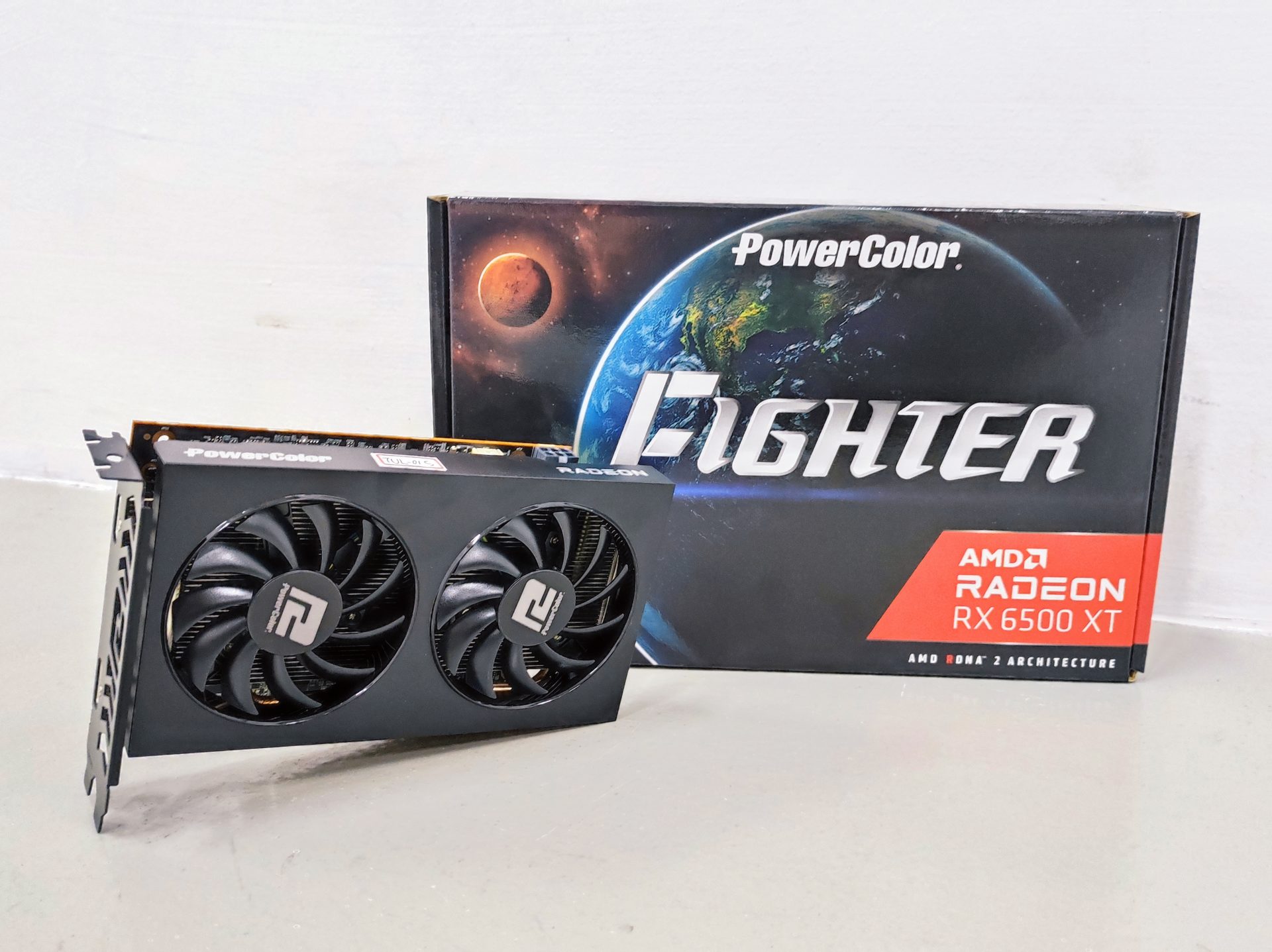At CES 2022, AMD announced the new Radeon RX 6500 XT graphics card targeted for budget-conscious gamers. The Radeon RX 6500 XT is said to be the most affordable graphics card that is capable of running games at 1080p resolution. Announced at a suggested retail price of USD$199, it could be a real contender for graphics cards in this segment, especially when competition’s latest budget offering, the RTX 3050 comes in at USD$249.
Previously, we mentioned in our review of the RX 6600 XT that it could be too expensive a graphics card just for 1080p gaming, and that it was more than capable of powering games at 1080p. We wished for a cheaper and less performing alternative, and sure enough, it’s here.
While the product may sound great for the majority of gamers who still run games at 1080p resolution, the actual performance of the card is what matters. Would it be able to meet the expectations of gamers, or will it fail miserably due to performance issues? We will learn more by putting the PowerColor FIGHTER Radeon RX 6500 XT 4GB GDDR6 Graphics Card to the test.
The PowerColor FIGHTER Radeon RX 6500 XT
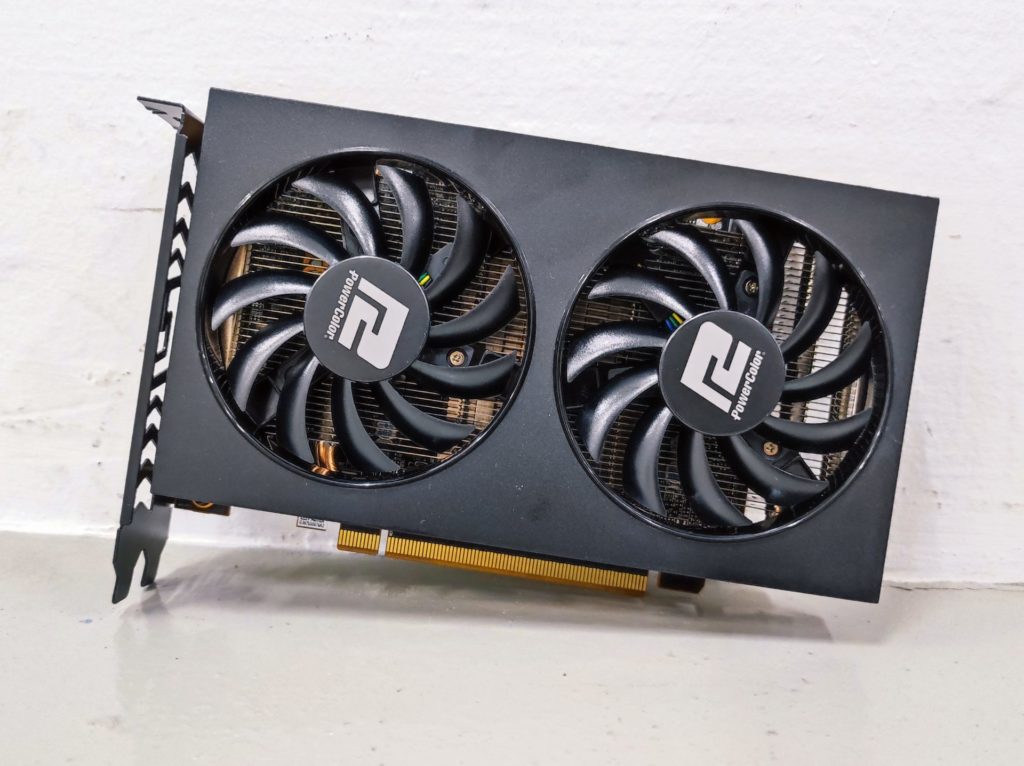
The PowerColor FIGHTER Radeon RX 6500 XT is created with a very simple design. It is equipped with 2 x 80mm fans to optimally cool the graphics card when required. As this graphics card is based on the latest generation RDNA2 architecture, it should also perform rather efficiently as compared to predecessors, and it is expected that it will run cooler as well.
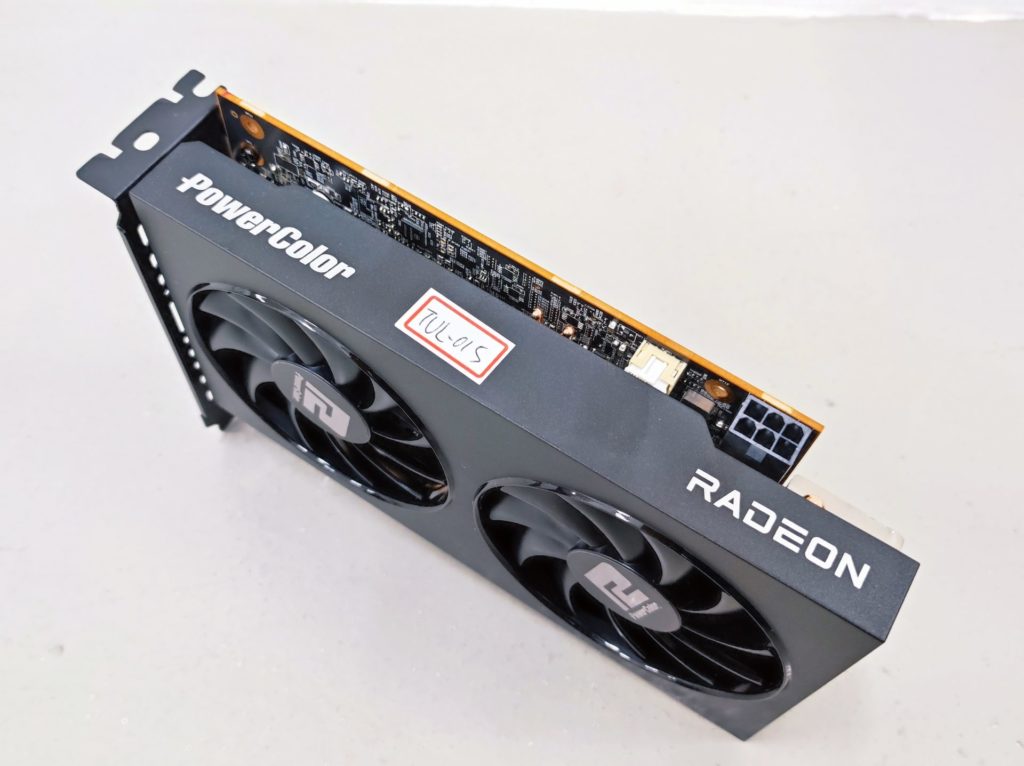
To power the PowerColor FIGHTER Radeon RX 6500 XT, you will only require an additional 6-pin connector. As the RX 6500 XT is rated to have a typical board power of 107W, it still required that additional 6-pin connector on top of what is provided by the PCIe slot to power it sufficiently.
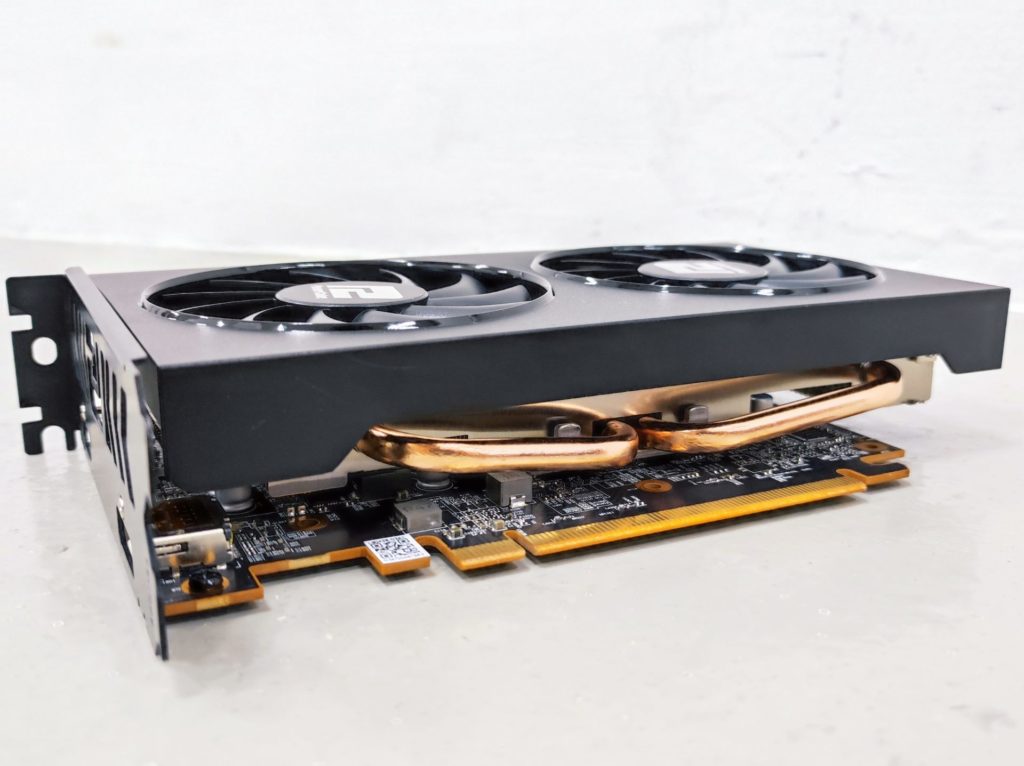
Despite it being a rather simple and straightforward graphics card, the PowerColor FIGHTER Radeon RX 6500 XT is still paired with a decent cooling system. The card is attached with a large heatsink that is connected with two heatpipes to properly cool the GPU and its surrounding components.
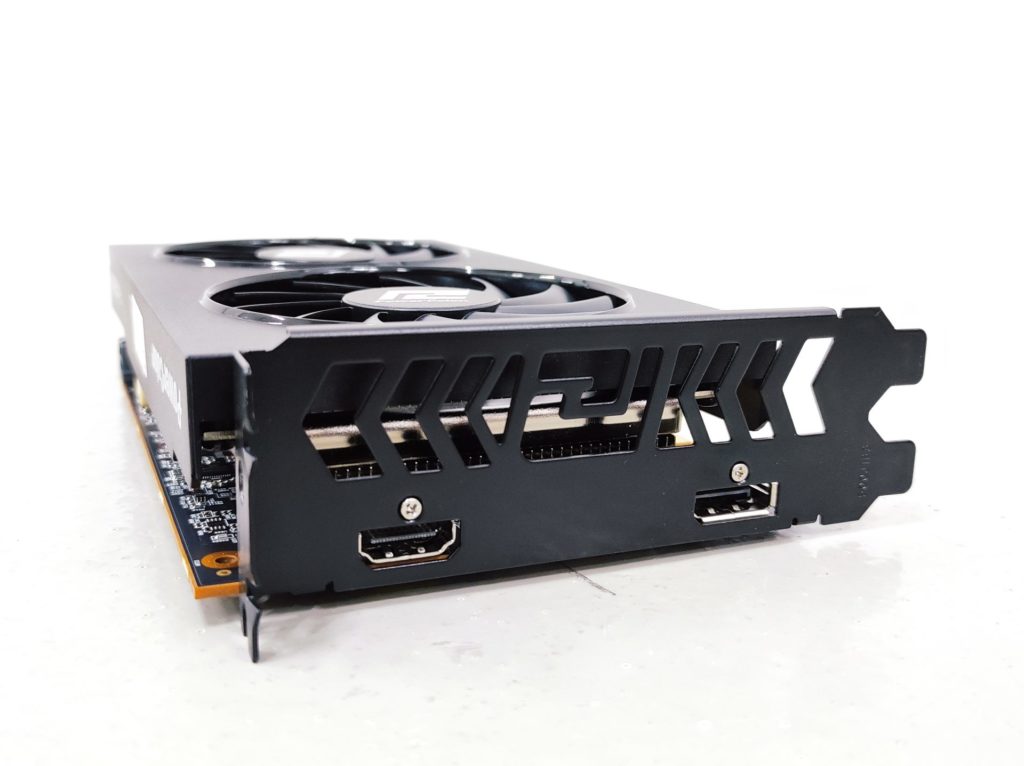
This card is quite limited in its graphics output, as it only has a single HDMI port and Display Port. We would have preferred if more display output ports were available on this graphics card. This would be useful for those who seek an inexpensive graphics card just for display output in a multi-monitor setup, and don’t require a powerful graphics card for graphics processing.
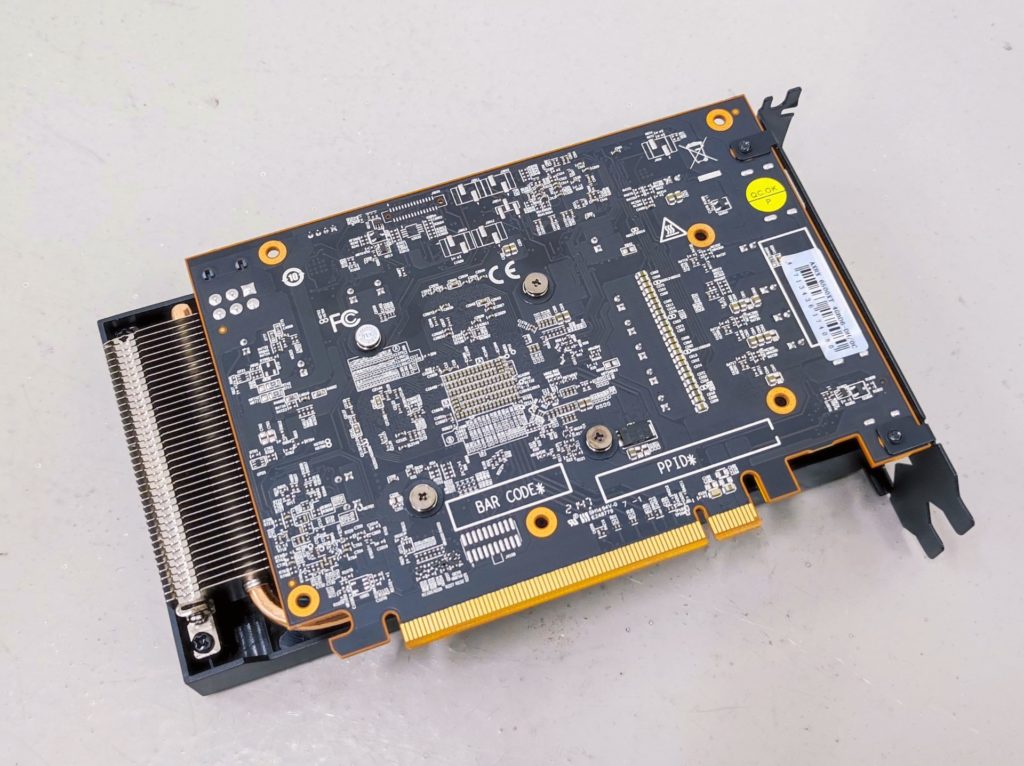
As expected of an inexpensive graphics card, the PowerColor FIGHTER Radeon RX 6500 XT also does not come with a backplate. It’s an logical exclusion, as the weight on the main PCB is considered insignificant to warrant additional physical support to the graphics card.
Specifications
| PowerColor FIGHTER RX6500XT 4GB | Sapphire Pulse AMD Radeon RX 6600 Gaming 8GB | Gigabyte AMD Radeon RX 5500XT 8GB | |
| Architecture | RDNA2 | RDNA2 | RDNA1 |
| Compute Units | 16 | 28 | 22 |
| Game Clock | 2650 MHz | 2044 MHz | 1530 MHz |
| Boost Clock | 2820 MHz | 2491 MHz | 1860 MHz |
| Memory Type | GDDR6 | GDDR6 | GDDR6 |
| Memory Size | 4GB | 8GB | 8GB |
Just based on specifications, it seems like the RX 6500 XT is significantly lesser equipped than its next bigger brother – the RX 6600. It has got 12 lesser number of compute units than the RX 6600, which directly impacts performance. Moreover, the RX 6500 XT is also considerably crippled by its memory size, as it can see that it only has 4GB of dedicated video memory. In fact, its previous generation RX 5500 XT even had twice the amount of video memory than the RX 6500 XT.
The comparison between the RX 6500 XT and RX 5500 XT’s performance should be interesting. Even though the RX 5500 XT is based on the original RDNA architecture, it has got more compute units to make up for its less performing compute cores. It even has more video memory than what the current RX 6500 XT has. It could even end up that the RX 6500 XT’s performance will be similar to that of the RX 5500 XT, which makes us wonder about RX 6500 XT’s place in the market.
Putting all the speculations aside, let us put our hypothesis to the test, and find out if the RX 6500 XT could really be as bad as it seems on paper.
Testing Objectives and Setup
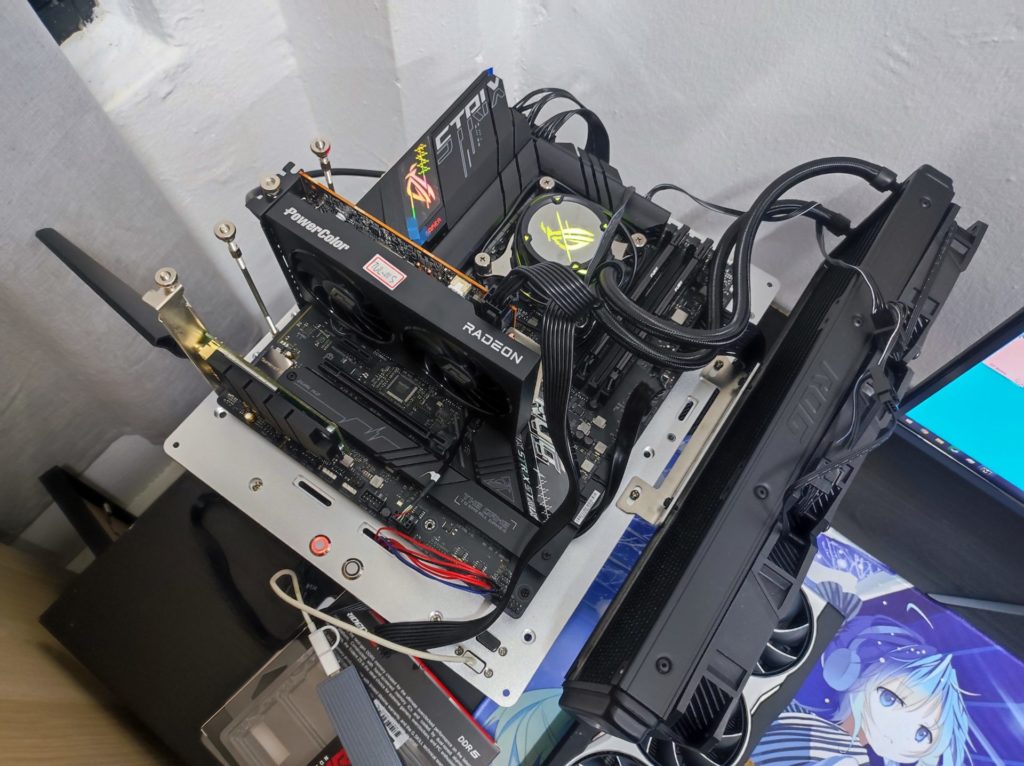
| Specs | Main System |
| CPU | Intel Core i9 12900K |
| RAM | Kingston FURY Beast DDR5 |
| Main Storage | Kioxia Experia M.2 500GB |
| GPU | PowerColor FIGHTER RX6500XT 4GB Gigabyte AMD Radeon RX 5500XT 8GB Sapphire Pulse AMD Radeon RX 6600 Gaming 8GB Gigabyte GeForce GTX 1650 D6 WINDFORCE OC 4G |
| Motherboard | ASUS ROG STRIX B660-F GAMING WIFI |
| CPU Cooler | ROG STRIX LC II 360 |
| OS | Windows 10 Pro 64 bit |
In our tests, we are going to put the PowerColor FIGHTER RX 6500 XT 4GB Graphics card to the test and compare it to its predecessor, the RX 5500 XT. Furthermore, we will also add the RX 6600 and GTX 1650 into the mix, to understand the performance difference between what’s next in line, as well as what’s still available from competition.
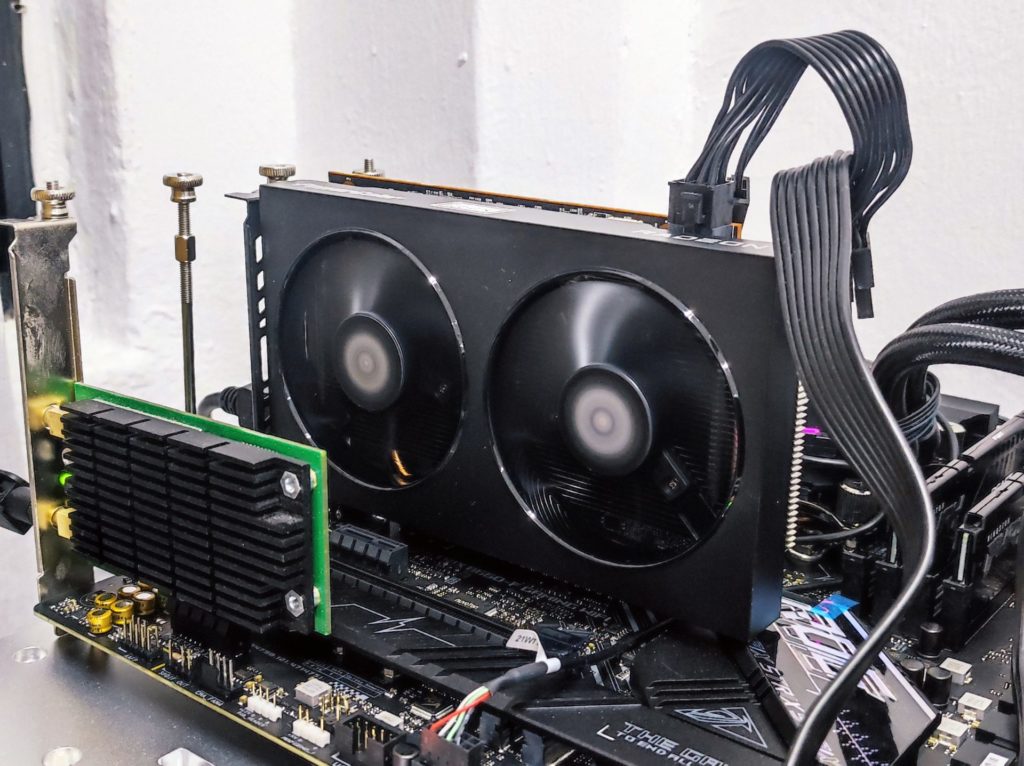
| Benchmark Test | Settings | API |
| 3DMark Time Spy | Default | DirextX12 |
| 3DMark Fire Strike | Default | DirectX11 |
| 3DMark Port Royal | Default | – |
| 3DMark Ray Tracing Feature Test | Default | – |
| Far Cry New Dawn | High | DirectX11 |
| Deus Ex Mankind Divided | High | DirectX12 |
| Total War Warhammer 2 (Battle) | High | DirectX11 |
| Tom Clancy Division 2 | High | DirectX12 |
| Assassins Creed Odyssey | High | DirectX11 |
| DOTA 2 | Best Looking | DirectX11 |
| Final Fantasy XV Benchmark | High | DirectX11 |
| World of Tanks enCore | Ultra | DirectX11 |
| F1 2018 Australia | High | Direct X11 |
| Shadow of the Tomb Raider | (1) High (2) High with Ray Tracing |
DirectX12 |
| Middle Earth Shadow of War | High | DirectX11 |
Performance Results
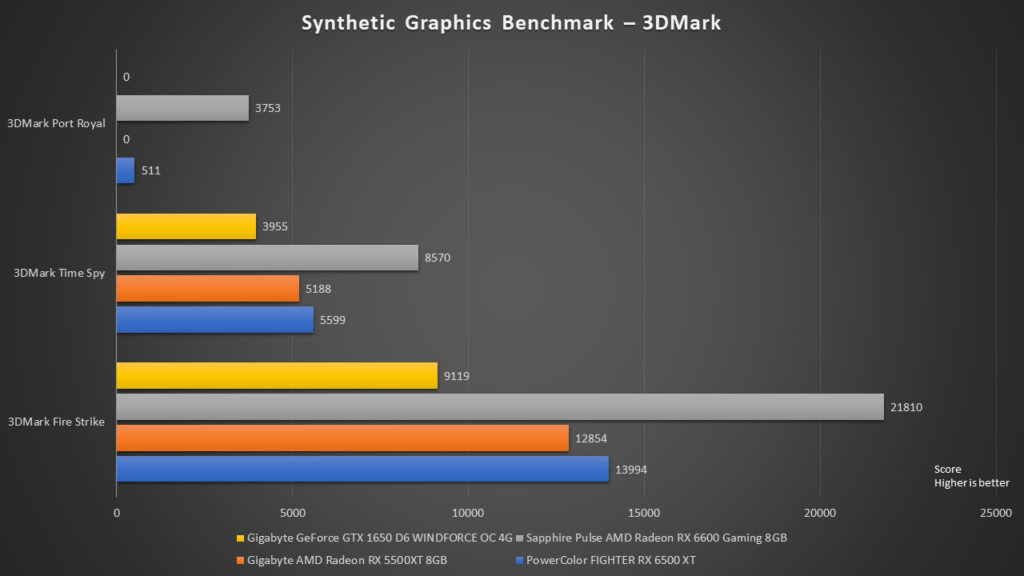
The synthetic benchmarks give us a good sensing of the performance levels for each of the graphics card. The PowerColor FIGHTER RX 6500 XT comes in second, showing that it’s faster than its direct replacement, the RX 5500 XT, and competition’s GTX1650. However, we can also see the huge performance difference between the RX 6500 XT and RX 6600, which makes us wonder if it’s actually worth it to just get the RX 6600 instead.
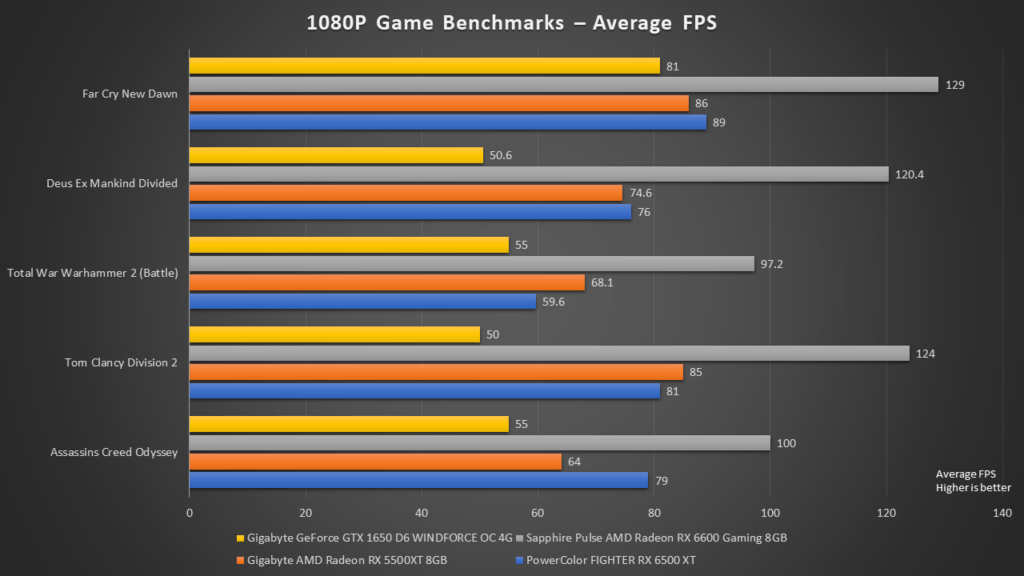


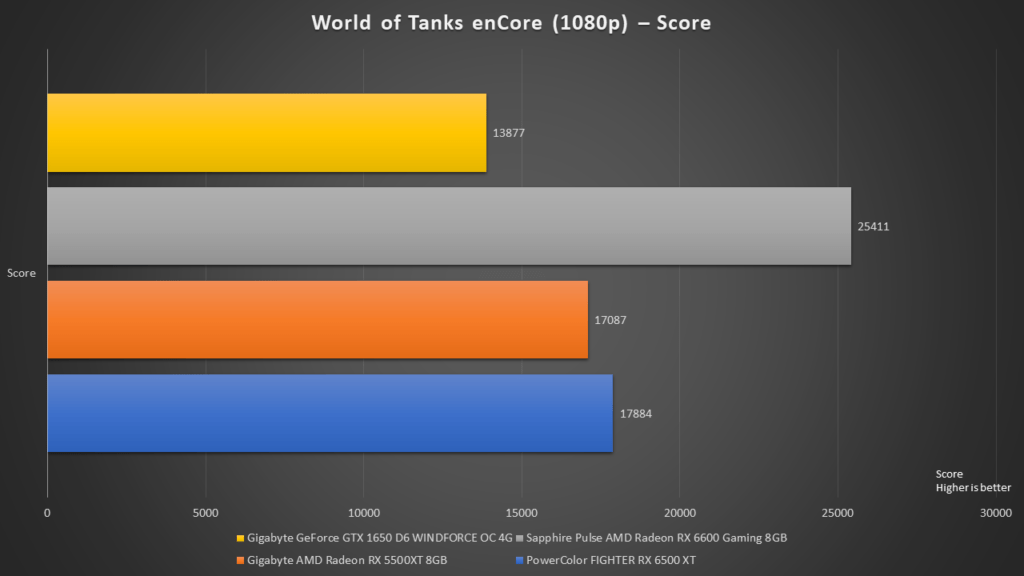
Moving the focus on the RX 6500 XT and RX 5500 XT, we saw that RX 6500 XT is generally faster than the RX 5500 XT. However, there were times where the RX 6500 XT came behind the RX 5500 XT, such as in the Tom Clancy Division 2 and Total War – Warhammer tests. As these games run heavy on the video memory, the 4GB video memory on the RX 6500 XT became a limiting factor, resulting in poorer performance than expected.
Power Consumption and Temperature
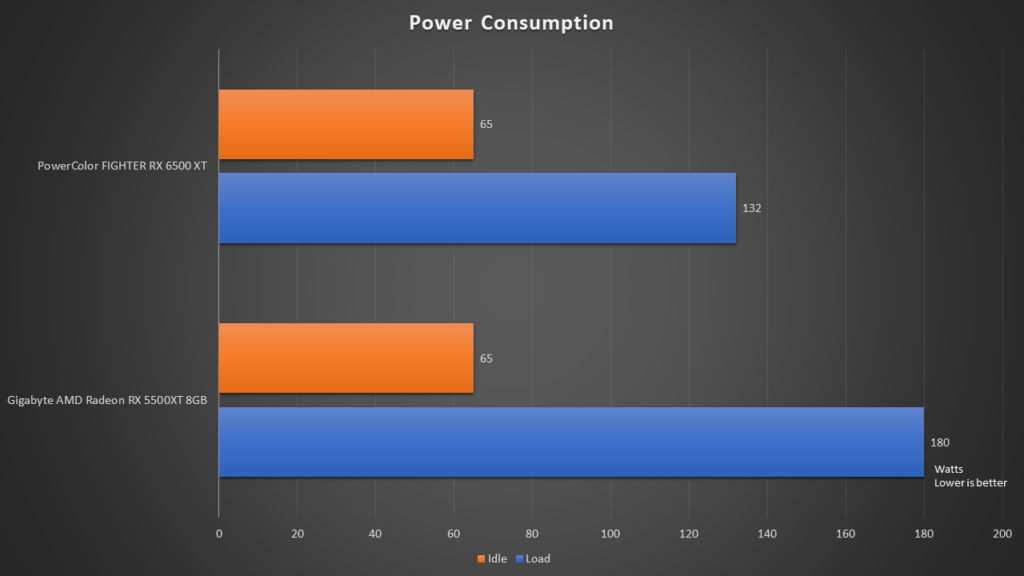
There is no doubt that the RX 6500 XT performs with better efficiency. Not only does it has a lesser number of compute units, its improved RDNA2 architecture also helps in compute efficiency.
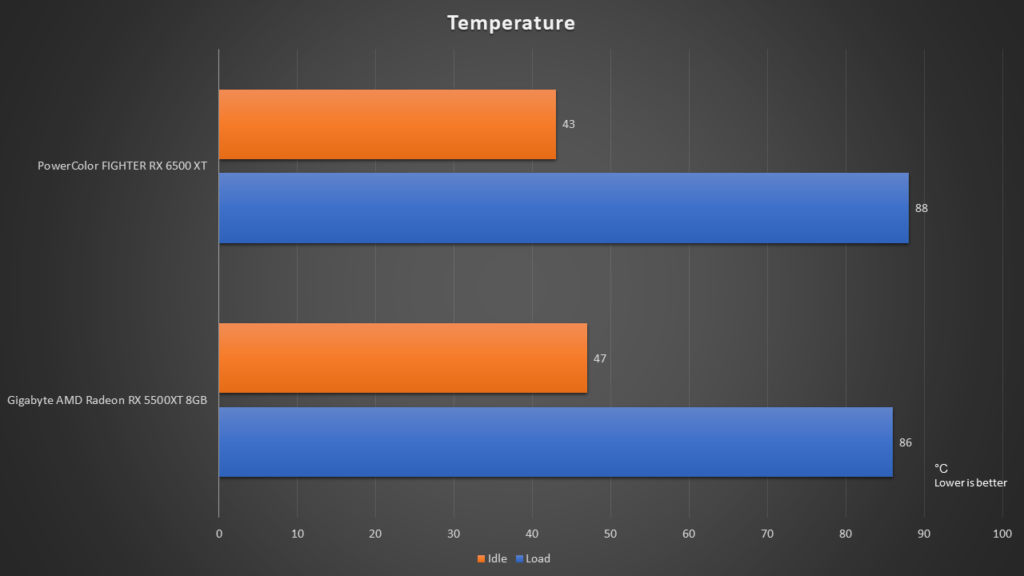
As for temperatures, both cards had similar idle and maximum temperatures recorded. Both cards utilize a “stop-fan” feature, which allows the card to be only passively cooled while on idle. This allows the card to remain silent when not running intensive graphics applications. Regardless, the PowerColor FIGHTER RX 6500 XT still remained quite quiet even when the fans are at 100%.
Final Words and Conclusion
In terms of performance, the PowerColor FIGHTER RX 6500 XT didn’t really leave us with an impression. It’s only marginally faster than its previous generation RX 5500 XT, and the fact that it has only 4GB of dedicated video memory worries us, as some games do require that additional video memory for it to perform even at 1080p resolution. In fact, even the RX 5500 XT did come with 8GB of dedicated video memory, so we weren’t sure why the decision was made to reduce the video memory on a newer generation of product.
The main benefit of the RX 6500 XT is that is indeed far better than the RX 5500 XT in terms of energy efficiency, thanks to its improved graphics architecture and reduced number of compute units.
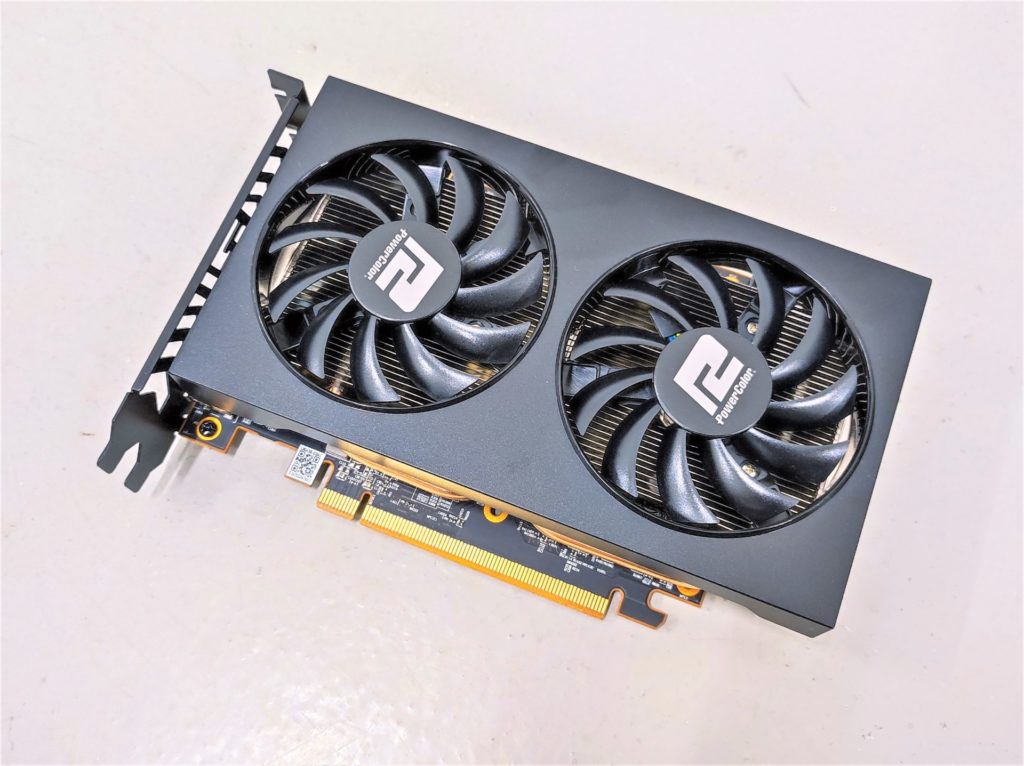
We were expecting quite a bit more performance in the RX 6500 XT, especially when it’s the direct replacement of the RX 5500 XT. The rather lackluster performance of the RX 6500 XT also means that AMD has left a huge performance gap between the RX 6500 XT and RX 6600. Their naming convention also tells us that it is less likely that they are going to announce something in between these 2 products, so we aren’t expecting anything more from the company.
To be honest, we wished that the RX 6500 XT could be even more competitive by featuring a higher number of compute cores and more VRAM, so that it would be an obvious choice for gamers. Now that the performance results have shown us that there isn’t any significant performance uplift over its predecessor, I can’t get over the thought of me getting something of similar performance at the same price of a previous generation card.
Nonetheless, by seeing what’s available in the market, the RX 6500 XT still possesses certain value. It runs most games at 1080p smoothly, and perhaps that is what all matters. It’s neither an obvious nor amazing product, but it works as it suggests. We just have to say that AMD has played a rather weak hand in this round of the GPU wars, even though they were already on the losing end.
This makes us even more excited and curious about the NVIDIA RTX 3050 graphics card, which doesn’t raise any red flags based on its specifications. Even though it’s USD$50 more than the RX 6500 XT, it would be an even more compelling product if it hits the performance sweet spot between the RX 6500 XT and RX 6600.


